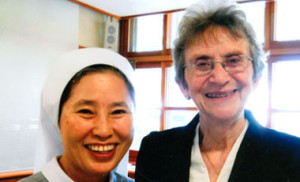Pastoral Ministry
Health Care
Youth Issues
Peace
Sister M. James Florence Blanchard
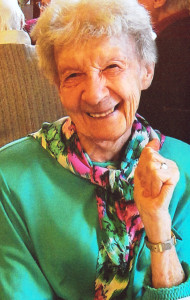
Sister M. James Florence Blanchard, MM, died Tuesday, April 14, 2015, at the Maryknoll Sisters Center. She was 86 years old and had spent 22 years with the people of Tanzania, teaching various classes and learning and embracing their culture. “If you have been to someone’s village you are a friend for life,” she commented.
As an educator, Sister James affected and improved the lives of many, teaching them life skills, such as sewing, infant care, socio-economic values and the benefits of a good diet.
Born on September 22, 1928, in Charlottetown, Prince Edward Island, Canada, to James Edward and Florence M. Gallant Blanchard, Sister James, or “Jamesy” as she was known by the other Sisters at Maryknoll, was christened Mary Florence Blanchard, attended the Notre Dame Academy in Charlottetown from 1943-1945, and graduated from Mount St. Vincent Academy, Halifax, Nova Scotia in 1947.
On September 6, 1947, she entered Maryknoll at their motherhouse in Ossining, NY, from St. Dunstan Parish, Charlottetown. She made her first profession on March 7, 1950 at the Motherhouse and was employed in the kitchen for a year.
In 1952, Sister James received her first overseas assignment, in which she was sent to Africa. Following completion of Kiswahili language studies in Kowak, Tanzania, she worked in a dispensary for over two years, making her final vows on March 7, 1953. In 1955, she was assigned to Nyengina, Tanzania, where she taught second grade, did daily office tasks, and taught women how to sew, while also serving as superior of the Maryknoll Sisters in that region, until 1956. She then taught sewing and did office work in other Tanzanian communities, including Rosana from 1956-1962 and 1965-1971, Kinesi from 1962-1963, and Isango from 1963-1965.
Sister James was then sent to Tarime, Tanzania, where she served until 1974 in rural community development. Noting that the local women had no dresses or slips, she taught them how to make inexpensive clothing. She also educated the people on their diets, taught them to use their cattle as food rather than dowry, taught them reading and writing, health, socioeconomics and homecare. “Twenty years ago, men were kings. Women didn’t have anything like their own money,” she noted in an interview during that time period. “Now they have their own gardens, bananas and cabbage. When they sell the produce, I try to make sure they keep what they earn.” Under her guidance, the men also became more willing to cooperate regarding health care, some of them even encouraging pregnant women to come in for an examination.
In mid-summer 1974, Sister James suffered a severe stroke and, once her condition stabilized, she returned to the Maryknoll Sisters Center in Ossining. There, she worked part-time in the Stamp and Mail Department until her death.
A vespers service will be held for Sister James, who donated her body to science, on Monday, April 20, 2015, at 4:15 p.m. in the Chapel of the Annunciation at the Maryknoll Sisters Center at Maryknoll, NY. A memorial Mass will follow on Tuesday, April 21, 2015, at 11 a.m. in the same location.
Responding to a Real Need in Korea
I became acutely aware of the need for more anesthesia providers in Korea as I was working at Maryknoll Hospital in Busan (previously Pusan). In many small hospitals, the medical doctor first gave the anesthetic, then operated, with no one watching the patient. This led to many unnecessary deaths which affected me deeply. Soon a kernel of an idea was beginning to take form–why not extend myself by teaching others to do anesthesia.
This is what I did. In 1970, with the support of our hospital administrator, the first class of nurses began. These men and women are still active in anesthesia, and have done exemplary work in the field over the years. I am so proud of them. As the students completed their study, they easily found placements in local hospitals which recognized their excellence in administering safe “watchful care” anesthesia.
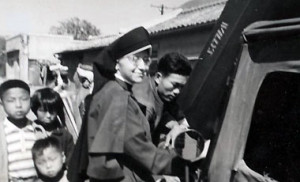
The next step was to have the program recognized as a certified program with the National Ministry in Korea. By the late 1970s, the program received approval as a certified program for nurse anesthetists, recognized by the Ministry of Health and Social Affairs. This was a moment of sheer joy for us all. I realized, in implementing the above and know now for sure, that it could not have accomplished this without the support, dedication and enthusiasm of the courageous men and women whom I had taught over the years.
As I reflect on those early years of our growth, what was so quickly noticeable was: initiating the NA program was a response to a real, felt need in Korean society in the field of anesthesia. The development of the KANA responded to a need for stability and organization: united together, we could effectively face the obstacles in our professional development and delivery of anesthesia. The KANA succeeded because of its devoted and committed members. In the formative years we received much support and assistance from members of the American Association of Nurse Anesthetists (AANA), namely John Garde, Ron Caulk and Sandra Maree Ouellette, who came to Korea as guest speakers several times at our annual meetings. We coordinated our meetings with those of the AANA and the IFNA, of which Korea is one of the Charter members.
In September 2014, I was pleased, honored and humbled to accept the prestigious Hermi Lohnert Award–and very special thanks to the International Federation of Nurse Anesthetists (IFNA) board for selecting me, to the AANA for arranging this ceremony (held in Orlando, FL, on September 13, 2014), and to those who nominated me and supported my nomination. Also an enormous salute to Marianne Reisen of Switzerland, the other nominee for this year’s award. And thank you to my friends and colleagues in the field who have inspired me nationally and internationally, to ensure the relevance of nurse anesthesia in this changing world.
Lastly, I feel this award could rightly be given to the nurse anesthetists of Korea, for without them, nothing would have been developed over the years. I had the kernel of the idea, they were the leaven which made it increase and expand beyond our dreams or expectations! Over the years, I watched the development of the nurse anesthetists in Korea, and the advancements they have made personally and professionally in so many ways. The people of Korea have been beneficiaries of excellent anesthesia care, and I realize how fortunate I am to leave this legacy to the nurse anesthetists of Korea, confident that they will continue to initiate timely advances in promoting the continued success of the profession on the Korean peninsula.
In closing, our Maryknoll Sisters foundress, Mary Josephine Rogers, left us a great legacy, and much wisdom. I quote her here, for it also applies to the work in Korea:
“There is nothing more astonishing than life, just as it is,
Nothing more miraculous than growth and change and development,
Just as revealed to us.
And as happens so often when we stop to regard God’s work,
There is nothing to do but wonder and thank God,
Realizing how little we planned,
And yet how much has been done.”
–Mother Mary Josephine Rogers, MM (1936)
I am extremely grateful for having been in anesthesia and having been assigned to Korea, where my life blossomed thanks to God’s grace and the many wonderful, faithful, creative and talented people with whom I met over the years. Thank you.
Holding All God’s People in our Hearts
By Sister Mary Ellen Kempken, MM
As we celebrate World Mission Day 2014, I recall the words of Dan Schutte’s song, Here I Am, Lord. In that song we hear God tell us: “I have heard my people cry… I who made the stars of night, I will make their darkness bright.” Then God asks, “Who will bear my light to them? Whom shall I send?” In the refrain we are given the chance to answer by responding, “Here I am, Lord…I will go Lord, if you lead me. I will hold your people in my heart.”
In these days the news is filled with the suffering of people facing the Ebola crisis in West Africa, with the terror and cry of people living amidst violence in the Middle East, with the concerns of people experiencing drought, floods or huge storms nearing their homelands. All these people look to someone to make their darkness bright. World Mission Day reminds us that we are all called and sent to share God’s light with our brothers and sisters throughout the whole world. They are looking for some Good News. If we are disciples of Jesus, then we do have Good News to share and we are all in effect, missionary disciples no matter where we are.
As a missioner in Bolivia, I remember one day watching families affected by the flooding of the Beni River in the northern Amazon region of the country. I realized that Jesus addressed not only learned scribes but crowds of people just like these families. It occurred to me, watching the mothers and children, that God knows each of us and that the Good News God would want us to have would never be a complicated message. The crowds in Galilee in the time of Jesus and ordinary people in Bolivia, in Tanzania, in Taiwan or in the Bronx today could begin to find hope by hearing from Jesus the Good News that they are loved by God.
The Good News is that God is Love and God holds each person like a loving parent. Each of us is made in God’s image and likeness and is therefore made to love and hold all people in our hearts, too. Jesus even pointed out who especially needs that love: the hungry and homeless, the ill and imprisoned, the prodigal son and the lost sheep. He said: Be merciful. Forgive. Rejoice. Just love. Not easy but not complicated. God is Love. Our life is all about love. And those families along the Beni River and many others throughout the world today should be able to find hope in that Good News: people can and will reach out to help one another through times of crisis.
As Pope Francis says in his message for World Mission Day 2014, ”the disciples were given an experience of God’s love, but also the possibility of sharing that love.”
This is not new. This is the core of our Christian belief. Teresa of Avila used the image of each of us being the hands and feet of Christ. And that was because love isn’t just a nice sentiment. It requires doing something. Each of us has so many gifts to share. And these many gifts can be a sign of God’s love for the person receiving the gift we share.
Some of us will share the gift of our prayers. And we know that prayer can bring about wonderful things. Some of us will share our gifts by directly reaching out and listening to, speaking with, and touching the persons who are suffering. Others will share the gift of themselves as they take the time to learn what others need and to network with other people and with those in the situation, advocating for the changes that must happen if our world is to be able to meet the needs we are seeing.
On this World Mission Day, I invite everyone to listen to God’s questions for today: “Who will bear my light to those suffering from violence, fear, illness, hunger, homelessness, isolation or rejection? Whom shall I send?”
May we all help one another to answer: “Here I am, Lord. I will go. I will hold your people in my heart.”
These Kids Are in Good Hands
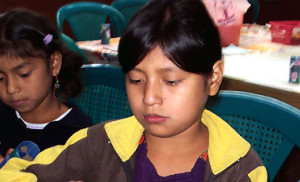
Those assigned to Chajul, a distant mountain town, are brought by their parents in vehicles filled with teaching materials, toys for children, enough food for a month, and their favorite pillows. These Monte Maria graduates, now college students in Guatemala City, volunteered in a spirit of adventure and service to help Ixil-speaking children in Chajul learn how to speak and read Spanish.
Last year, I had signed up 30 first-graders, 30 second-graders and 20 sixth-graders for remedial classes in Spanish and math. The volunteer mentors quickly organized themselves into a teaching team covering five days a week for four weeks. In addition, a few went with our priest to a distant village where they sloshed through mud, ate unfamiliar food, and witnessed the hard life of the people in the rugged countryside. All of them caught a variety of colds from their students. One sprained a ligament in her knee after too much mountain climbing. One had a few spontaneous and scary nosebleeds. And all took turns cleaning toilets, sweeping and mopping floors, washing dishes and cooking supper. In return for their volunteer service, the volunteers eagerly learned from their pupils how to speak a few words of Ixil and set themselves to learn to weave from some of their older students.
Before leaving Chajul, the group sat around my kitchen table talking about their experiences and a few shed tears. They had never seen such poverty, much less experienced it firsthand. They admitted to being deeply touched and permanently changed in those few weeks. Comparing their privileged lives in the capital with the lives of the children of Chajul, they wondered aloud how they could help them once they returned home.
In my kitchen that evening was born a project: to contribute during the next year to the education of six of the children. With very little free time left, these determined young women made arrangements with the children, the parents, the schools, and the banks to make their plan a reality. Several months later, the project was continuing as planned, and the Monte Maria graduates, now college students, were keeping in touch with their protegées in the countryside.
The volunteers from Guatemala City added a whole new dimension to my ministry with their one-month mission to Chajul. Each year, they had collected so much learning materials from other Monte Maria students that, when each year’s new group of volunteers arrived, they brought children’s books, loads of paper, games, paints, and lots of other materials. Each year I had to add more shelves to store everything they left.
This year in June, two of the Monte Maria graduates who served last November wanted to come back for a week during their vacation and plunged right in where they had left off.
An Archbishop Says ‘Thank You’
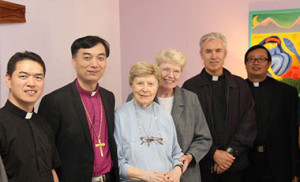
It was a thrilling experience to once again meet Archbishop Francis Lu, Sister Maria Zheng and Fr. Anthony Guo, all of whom I worked closely with during the four and a half years that I lived in Nanjing. During that time, Sister Maria Zheng and Father Thomas Goa were granted scholarships through Maryknoll Society’s China Project to study in the United States. Also during that time, Father Larry Lewis volunteered to give a retreat to the clergy in Nanjing Archdiocese.
With the gracious assistance of Sister Betty Ann Maheu, we welcomed Archbishop Francis and his entourage with refreshments in Molly’s Suite. After introductions and a presentation of gifts by Archbishop Francis to the Community, Sister Betty Ann gave the group a tour of the Heritage Museum, especially stressing our beginnings in China. We prayed together for world peace in the Main Chapel, after which we wended our way to Maryknoll Sisters’ Residential Chapel on the fourth floor where Archbishop Francis, Father Anthony Guo and Father Joseph Gu concelebrated the Eucharist in Chinese. After Mass both Archbishop Francis and the Sisters in wheelchairs could not get enough of each other. While shaking his hand, they all wanted to tell him where and how long they were in mission, especially the old China hands.
Finally, we were able to enter the elevator and descend to the first-floor main dining room, where Sister Betty Ann and Laura had lovingly decorated two tables with white tablecloths, flowers, place marks and gifts. The group was in awe of the size and beauty of the dining room with its side views of flowering shrubs both in the courtyard and street side. It was probably a first for the seven men to pick up their plates and food on the serving line, but for the three women it was not too unusual. During the meal, the Maryknoll Fathers Superior General Edward Dougherty and Father Timothy Kilkelly, director of the Maryknoll China Project, joined the group for dinner. There was a small reunion, as a few of the Sisters in the dining room recognized Sister Maria Zheng from the time she was at the Center studying English.
After the meal, just as we were beginning to say our goodbyes and turn the group over to Father Tim for a tour of the Maryknoll Society Seminary, Archbishop Francis asked to see the statues of Mother Mary! Since they had already seen the beautiful statue of Our Lady of Maryknoll in the front foyer, I had to think which other statues had he in mind. Then, I remember he probably wanted to see the grotto of Our Lady of Lourdes. Almost every Catholic Church in China has a grotto of Our Lady of Lourdes outside the Church. Immediately on arriving at the grotto, Archbishop Francis gathered the group around him to pray.
Next we moved to the Maryknoll Sisters Cemetery. Everyone was enthralled with the grounds and the graves, reading the tombstones! Finally one member of the group asked why one grave was still open. I told them we were preparing to bury Sister Helen Gleason, who just died. She would be in the same grave as Sister Marge Kulage, who recently passed away at 107 years of age. They were utterly astounded, since earlier I had told them their host, Sister Betty Ann, was 91 years old. After praying to Our Lady of the Thorn Crowned Head at Mother Mary Joseph’s grave, the group was ready to head over to the Seminary. I said goodbye to Archbishop Francis Lu, Sister Maria Zheng and Father Anthony Guo and the other members of the group, thanking them for coming to express their gratitude for Maryknoll’s service to China, especially Nanjing Archdiocese. We then turned the group over to Father Timothy Kilkelly who would give them a tour of the Seminary.
– See more at: https://www.maryknollsisters.org/articles/archbishop-says-thank-you#sthash.CgjYdyIH.dpuf

